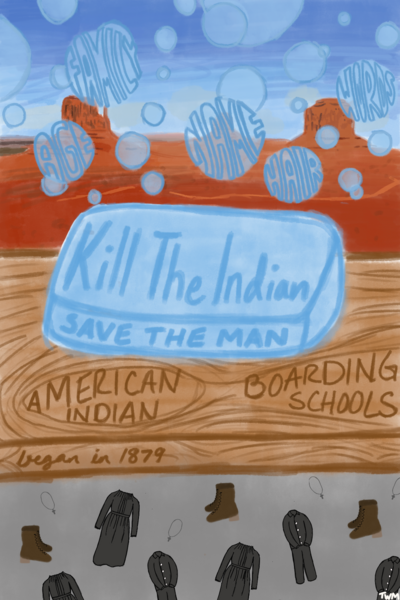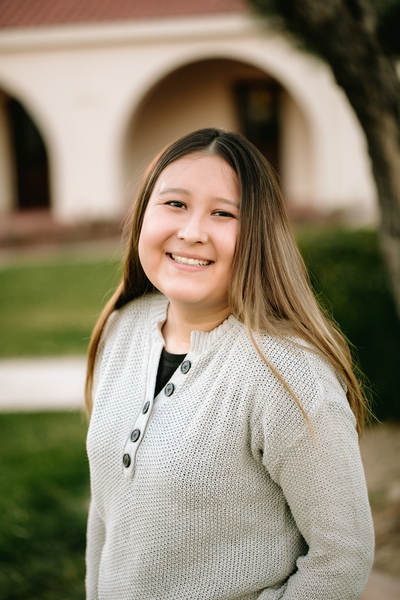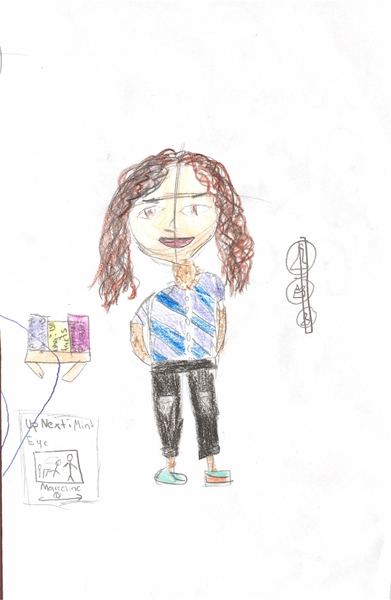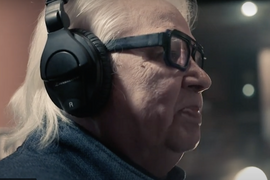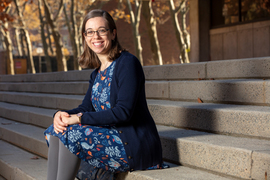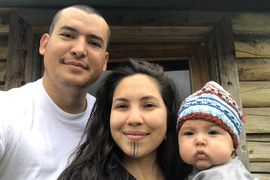Jeff Toney would like you to think differently about who’s doing the teaching at MIT. The visiting professor in the MIT Department of Linguistics and Philosophy piloted an ambitious Independent Activities Period (IAP) project, bringing together students from MIT and Wellesley College to explore the rich trove of knowledge each student already possesses as a cultural inheritance.
“STEM education is rooted in a tradition of students mentored by masters and icons of their field,” says Toney, who is also the provost and vice president of research and faculty at Kean University. “Student success is often determined by learning how to think like a scientist or engineer, and by a student’s ability to adapt to and model the behavior and culture of their mentor and the campus environment.”
This top-down model of education may help create excellent engineers, but it creates a somewhat hierarchical learning dynamic. Toney’s IAP aimed to overturn that dynamic. “I challenged four culturally and linguistically diverse undergraduate students to complete a remote research project on a topic well outside of their comfort zone: to examine how their culture, gender identity, or language could enrich the Institute.”
Toney’s vision for IAP recast his students as the expert curators of a trove of cultural knowledge only they had the keys to unlock. The results are a series of works as diverse as their creators.
Using words and images to reflect indigenous struggles
“My Navajo culture is really important to me, and it’s what I wanted to tackle,” says MIT second-year student Trinity Manuelito of her work, which uses graphic design to explore four important aspects of that identity. “As I’ve grown older, I’ve done a lot of work to dig into my own identity and learn more about it, because a lot of the information you encounter out there is badly skewed. I have seen a big disparity between my culture and how it is taught in schools. Being the only Native American in your classroom, and being asked to be not only a spokesman for your tribe but for all Native Americans, is incredibly uncomfortable!”
A 6-1 (Electrical Science and Engineering) major at MIT, Manuelito challenged herself to communicate accurate information about her culture via an artistic, rather than a technical, medium. “Because I was in a STEM-guided path, I wanted to challenge myself and do something new, so I went with art, which is a great way to share emotions and stories. I decided to use graphic design, made a list of ideas split between contemporary issues and history, then narrowed the list down to four core ideas and spent a week developing each project.”
Manuelito’s four projects focus on the reservation system, lost languages, the boarding school experience, and the Missing and Murdered Indigenous Women and Girls (MMIWG) movement. Each topic represents an immediate, personal connection for Manuelito, who lived until kindergarten on a reservation and repeatedly returned to visit friends and relatives, including her cheii (maternal grandfather), who attended one of the boarding schools. Manuelito was determined to impart a sense of the personal scope of her topics, which are often taught to non-Natives only within the context of a history class. “That’s a big part in Native American history and culture as a whole, because I’ve met so many people who are like, ‘You are the first Native American person I’ve ever met!’ There’s this perception that Native Americans lived like, a billion years ago, and they’re all gone, and we’re not! We’re still here,” says Manuelito.
To bring her grandfather’s boarding school experience to life, Manuelito chose the visual metaphor of a bar of soap engraved with the phrase, “Kill the Indian, save the man” — the chilling motto which the boarding schools used to justify their mission of cultural erasure. The soap is more than metaphorical; as Manuelito explained, her cheii was punished for speaking his native language by having his mouth scrubbed out with soap. “Professor Toney put a lot of emphasis on language and the power of words, and within each picture, you can see the words within the picture,” she reports, pointing out the soap bubbles in the work, which are washing away concepts like “family,” “hair,” “words,” and “name.”
Manuelito also brought her talent for a well-chosen word to her work on missing and murdered indigenous women girls, a human rights crisis spanning both the United States and Canada. “If you look closely at the image I created, I put information about the movement and the crisis on the side of the image in a very light, hard-to-read font, which communicates the underlying message that there needs to be more done,” says Manuelito. “That lack of information is honestly reflective of the way Native Americans are treated in society. We need actual numbers for it, we need to get the message about this crisis out in the media.”
Already, Manuelito is seeing her artwork’s effect; her proposal to present at the 48th Annual Symposium on the American Indian has just been accepted, and she is busy preparing her talk. Her work has also hit home in a personal sense: “I took time to talk to my mom and go through all my art. She called a couple of my pieces ‘poignant,’ which really stuck with me because at the beginning, I’d chosen this art path as a way of doing something fun and different than my STEM-oriented work,” she reports. “That’s what this project was at the beginning; and then Professor Toney showed me the impact my work can have, and I took it a lot more seriously. The reactions this project has gotten showed me that this work is important and there’s a need for this.”
Demystifying college for immigrant students
Wellesley sophomore Regina Gallardo knew firsthand the need for her own project, which uses art to spark conversations about college between immigrant children and undergraduate mentors. “I am an art history and American studies major and I work at the Davis Museum at Wellesley College, so my biggest loves are art, art history, and bringing underrepresented people into artistic spaces,” says Gallardo. “I emigrated to Doral, Florida from Mexico City when I was 12. As a teenager, I participated in a Miami volunteer program called the Pérez Art Museum Teen Arts Council. That experience was the first time I got to use art as a platform for social change and conversations, and it really influenced the work I wanted to do later.”
As a teen, Gallardo created an educational comic book about American rules for traffic safety, aimed at children from diverse cultural backgrounds. The book was printed and distributed throughout Doral public schools, giving Gallardo a sense of her art’s potential. “As I was working on the traffic safety project, I became more interested in the idea of influencing culture. I knew I wanted to work with immigrant children, because I’d been one myself, and I live my life working to help and open doors for others that are coming after you.”
First, however, Gallardo needed to surmount the imposing bureaucracy of college admissions in her new country. “A lot of immigrant children come to this country seeking political asylum, and many may not have brought documentation from their home country’s education systems. Or they have, but the system is completely different and the grades and exam results don’t really transfer,” Gallardo explains. “I experienced this firsthand during the college application process, translating everything to my parents, sitting down with them to do FAFSA, and there are so many things about the process that they didn’t know. Many students in the same circumstances end up not attending college.”
Gallardo decided her project would focus on demystifying the American college application process, and would begin with middle school-aged students. “I started to develop this pilot program between me and a student who is in 7th grade now. We met [over Zoom] to create drawings about her and her life through comic books,” Gallardo explains. “The first learning module involves drawing yourself and your favorite objects. I sit down with the student and have a conversation about themselves, their school, their passions, etc., and then I started to ask them about the objects which they are drawing to develop that relationship.” Gallardo learned that her mentee enjoyed math competitions and counted aerospace engineers among her heroes. “She wants to go to a tech-focused school like MIT or Caltech.”
The conversation was particularly encouraging to Gallardo. “My mentee said something really cool: ‘Oh, my friend wants to go to Harvard, can she also join this mentorship program?’ This was in our second meeting! I thought, she is actually enjoying this! When you’re 12, you’re just trying to figure yourself out, and it’s harder when you add cultural assimilation on top of that. I hope this program will help ease people into the idea of higher ed, and ease that process between childhood and adulthood.”
Gallardo’s program facilitates an open exchange of information, in which mentors answer questions not only about their college experience, but about the overall high-school-to-college pipeline. “The parent is present throughout the program, and it is designed to help them learn about the process of preparing for college, planning for it, going through the steps, and applying. You really have to start preparing in your freshman year, which is why middle school isn’t too early to start having these conversations,” says Gallardo. “We want the students to see themselves represented in places like Harvard and Wellesley and MIT, and we’re using comic books and art to connect with them. Art is a good way to be vulnerable and expressive and in tune with your emotions, and to build a connection.”
Along the way, Gallardo fine-tuned her approach based on conversations with Toney. “I recently met with Prof. Toney to talk about other immigrant communities and how students see themselves in higher education, which is very important. There is a lot of work we all need to do to create inclusive spaces, and it’s going to take time, but I am optimistic.” Manuelito shares Gallardo’s sense of cautious optimism: “I’m really glad to be a part of this moment, but there’s definitely a lot left to do. MIT is not perfect. And I love this school — I love MIT; but there is a long way to go.”
For his part, Toney is proud of his students’ ambitious and impactful projects. “This IAP provides an example of how institutions of higher learning can become stronger, enhancing teaching and learning and broadening the societal impact of research, by valuing and adapting to the rich diversity of the culture, gender identity, and languages of their faculty and students,” he says. Far from seeing cultural differences as a source of friction, Toney views them as an endless source of valuable perspective.
“Future generations of scientists and engineers could be better prepared to take on society’s challenges by seamlessly integrating their identity into problem-solving,” Toney says. “By mentoring students across STEM fields and the arts and humanities working together, I have found that application of an autoethnographic approach, commonly used in a wide range of fields including anthropology, can result in highly creative solutions. This is, after all, the very reason these institutions were founded — to advance learning towards a better world for humanity.”
